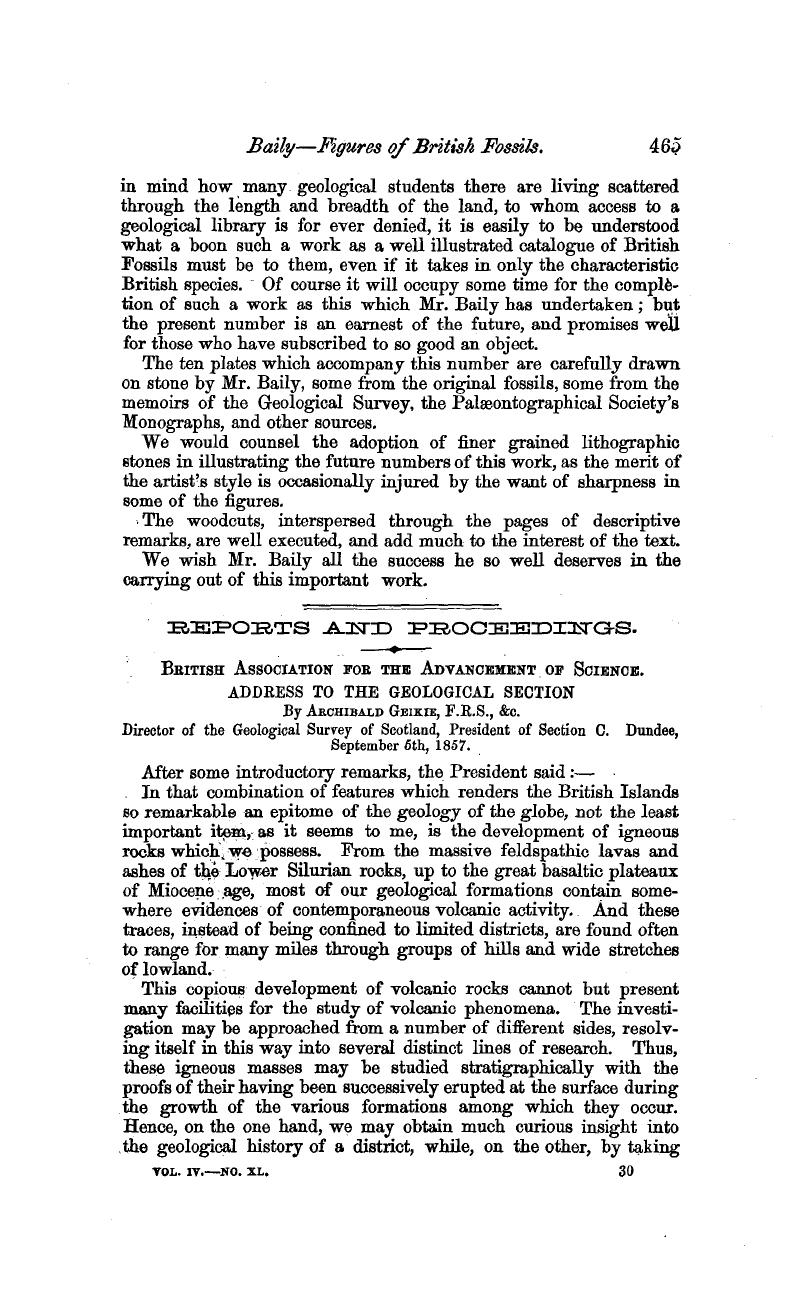No CrossRef data available.
Article contents
Reports and Proceedings
Published online by Cambridge University Press: 01 May 2009
Abstract

- Type
- Reports and Proceedings
- Information
- Copyright
- Copyright © Cambridge University Press 1867
References
page 467 note 1 See Murchison, “Siluria,” p. 83. Ramsay, Descriptive Catalogue of Bock Specimens in Jermyn Street Museum, 3rd Edit., p. 8. Mem. Geological Survey, vol. iii. p. 21 et passim.Google Scholar
page 467 note 2 Jukes, , Manual, p. 454Google Scholar. See also Memoirs of Geol. Surv. Ireland, Explan. to Sheets 102, 111, 147, 167.Google Scholar
page 467 note 3 Mem. Geol. Surv. Ireland. Explanations to Sheet 160, etc., p. 21.Google Scholar
page 467 note 4 In the Upper Old Bed Sandstone of Scotland proofs of volcanic activity remain to be gathered. The chain of the Pentland Hills which I formerly regarded as belonging to the upper member of the formation, I have since1 found to be covered unconformably by it, while the chain of the Campsie, Kilpatrick, and Renfrewshire Hills seems to belong wholly, or at least in great measure, to the lower part of the Carboniferous series.
page 468 note 1 Mem. Geol. Serv. Ireland. Explanation to Sheet 184. See also Explanation to Sheet 153, p. 18.Google Scholar
page 468 note 2 De, la Beche, Devon, and Cornwall, , pp. 51, 70.Google Scholar
page 468 note 3 Ibid., p. 122.
page 468 note 4 Manual, p. 523.Google Scholar
page 469 note 1 The trap-rocks forming these hills are interstratified in their upper portion with the Carboniferous Limestone. Their base rests sometimes on a set of marls, shales and cement-stones, and sometimes on a thick group of red sandstones. These strata contain Carboniferous plants; even thin coal seams lie among their higher members, and although the red sandstones have been hitherto generally called Old Red Sandstone, it is not unlikely that they may require to be relegated wholly to the lower portion of the Carboniferous series.
page 469 note 2 See Maclaren's Fife and the Lothians. Mem. Geol. Survey, Geology of Neighbourhood of Edinburgh. Trans. Roy. Soc., Edin., Vol. xxii., p. 644.Google Scholar
page 469 note 3 See Mem. Geol. Surv. Ireland., Explan. to Sheets 143, 144, 153, and 154; also Jukes' Mannal, p. 325.Google Scholar
page 470 note 1 See Geikie, , Geol. Mag., Vol. I. for June, 1864, p. 22.CrossRefGoogle Scholar
page 470 note 2 SirDe la Beche, H., Devon, and Cornwall, , p. 199Google Scholar. See, also, Conybeare, and Phillips, , Geol. England and Wales, p. 294.Google Scholar
page 470 note 3 See E., Forbes, Quart. Journ. Geol. Soc., vol. viii. p. 108Google Scholar; Geikie, , Trans. Roy. Soc., Edin. vol. xxii. p. 649;Google Scholar and Proc. Roy. Soc., Edin. 1866–1867.Google Scholar
page 471 note 1 See scenery of Scotland, viewed in connection with its Physical Geology, p. 278.Google Scholar
page 474 note 1 Boné felt this difficulty, but he conceived that the fissures had been filled from above by masses of basalt, erupted at different points, and spreading over the country, though now removed by denudation. He says:—“Nous croyons infiniment probable que ces filons ont tous été formés de même [i.e., remplis par des courans de lave dans leur marche], malgré lea grandes destruction qu' entraine cette supposition, et que rarement il y en a eu quelques-uns qui ont été remplis latéralment ou de différentes manières bizarres.”— Géol. d' Ecasse, p. 272.Google Scholar




